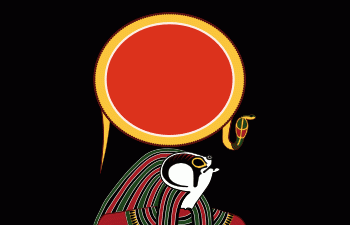All hail the sun! The sun be kickass. All hail the sun… is what they must have said centuries ago. And why wouldn’t they? Who wouldn’t want to worship that big glowing ball of fire in the sky? Helping life grow. Making people all warm and fuzzy. Luring them to take off all their clothes and lie down on the beach. The sun must’ve been God. So they prostrated towards the East, sang sonnets of its greatness, chiselled images of its splendour; hoping to accelerate his welcome.
The ideology of worshipping the sun wasn’t isolated.Let’s start of with the Ancient Egyptians who considered Ra, the sun god, to be the King of the Gods, the bringer of light, and patron of the pharaohs. You didn’t want to mess with Ra. He sports a coiled serpent around a sun-disk resting on that bad-ass falcon head of his.
During the day, Ra was believed to roam the sky in his slick solar boat… you know, just cruising. Every evening as the sun dipped below the horizon, it was thought that Ra was swallowed by the sky goddess – Nut. On his night boat, he would then crisscross through the underworld and back towards the east in preparation for his rebirth again by Nut. That’s the way he used to roll.
For people in ancient Egypt, the sun was what made the crops grow each season. So it is of no surprise that the cult of Ra had immense power and was widespread. Later the pharaohs themselves wanted to get in on some of this sun action. Since they were seen as incarnations of Ra, it gave them absolute power. The kings too knew which side their Egyptian bread was buttered and built temples and pyramids in his honor – after all, keeping Ra happy virtually guaranteed a long and prosperous reign as pharaoh.
Travel further west and you will find that other similar societies that were primarily agricultural and depended on the sun for life and sustenance, found great interconnectedness between the cycles of the sun and the cycles of planting and harvest of corn. Like the Mayans for example.
We know about the Mayans don’t we? Those creators of inaccurate apocalyptic calendars. Well… they did other cool things largely because of the sun. Mayan architecture was designed to create special effects on solstices and equinoxes. At Chichen Itza, during the equinoxes, a serpent form is created by triangles of light and shadows that represent Kulkulkan (the feathered snake deity that brings the light from the sun to the earth).
Then you have the Incas. Inti was the Inca god of the sun and considered all-powerful. But he was also a benevolent god and capable of great generosity. However, Inti could really get pissed off sometimes and he would demonstrate his displeasure through solar eclipses which necessitated sacrifices to win back the god’s good favour. That’s why the llamas in the area hated solar eclipses.

Source: http://intiraymimystic.com/wp-content/uploads/2012/11/Inti-Raymi-Fiesta-del-Sol-Cusco-Peru2.jpg
The Mayans and the Icas had Intihuatana stones (meaning ‘Hitching Post of the Sun’). It was used during the solstices to symbolically connect the sun to the earth using a special cord.
Intihuatana stones were systematically searched for and destroyed by the Spaniards. The only one still intact is the one at Machu Picchu which remained hidden from the conquistadores.
The sun god’s worshippers and the vast majority of the art made in his name have long since disappeared but Inti makes his presence felt in several present day South American cultures. The festival of Inti Raymi (Festival of the Sun) for one, has been revived in Cuzco. The currency of Peru in the 1980s was called the Inti. Also, several national flags bear an image of him in the form of a flaming sun. Inti lives on.
Think About It
Our ancestors were pretty hardcore about the sun and some of their rituals may seem a tad extreme. But maybe within their imaginative stories, there’s a lesson for us somewhere. They knew the sun was the source of power and energy. It’s one of the major elements that makes our earth tick. How much are we losing out by sitting in the shade, in front of our little screens and air-conditioned rooms. Are we giving the sun it’s due?
About the Authors
Nash hopes to help open minds to the wondrous stories that exist all around. He’s a freelance graphic and web designer.
Jonathan Dias freelances for magazines and papers like Maxim and the Herald, writing about women, food and gadgets. He is also attempting to write a cook book that involves a lot of bacon and beer.







